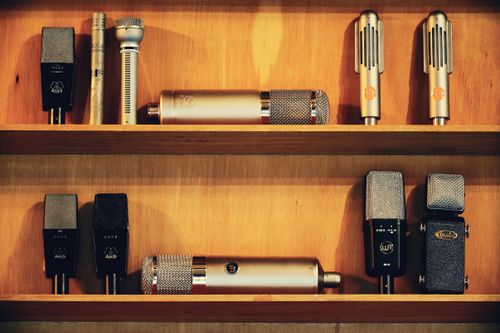
Tools of the Trade
for the
Stories of Strangers
Stories of Strangers is the culmination of more than 3 years of composition and comradery. We began recording in the winter of 2018, thinking to finish by summer, but instead production rolled on until autumn – 2 years later.
Right from the outset we knew we wanted to record the album ourselves and to do it entirely in analogue. Recording to tape has a warmth and quality that’s difficult to emulate digitally but perfect for our sound and songwriting. Sal used to run such a studio back in Los Angeles and this provided the perfect opportunity for him to acquire, repair, and restore the gear to build another: Year of the Rabbit Studios.

All songs were performed and tracked live in the studio. Drums were mic’ed “Glyn Johns style” with 2 overhead ribbon mics (Extinct Audio BM9s) and 2 dynamic mics for the snare and the kick. A rare AKG D19C was key to the timbre of the guitar, as were C414s for the rest of the stringed instruments and harpsichord. A Violet Amethyst Vintage was used for the bass and a BM9 gave the flute its warm and tailorable tone.

Having only 8 tracks to work with at a time created quite the logistical challenge when trying to fit our arrangements to them. Considerable planning and inventiveness was required, especially for an 8 minute multi-part suite like ‘The Minstrel’.

The 1967 Ampex A-440A 8-track tape machine and the backbone of the studio and the sessions. All tracking was done to it, all mixing was done from it, and much money was spent on it. Despite its venerable age it coped magnificently, running for up to 40 hours a weeks for 2 years straight.

The foundation tracks for each song would be mixed to stereo onto new 8-track reels on this borrowed 1969 Scully 280B. This two-stage process gave us an extra 6 tracks for vocals and other overdubs, but it also meant there was no way to adjust or rework the mix of the foundation tracks.

The final stereo mixes were captured with this 1969 Ampex A-440B 2 track. None of these tape machines have auto-location or even a tape counter, making precise queuing difficult. And all of them could take a few seconds to reach the correct speed after hitting record, making punch-ins impossible.

Mixing was done in real time with the studio’s Soundcraft TS12 console and a lot of coffee. There was no automation. Every channel and group had to be faded, muted, panned, eq’ed and fx’ed by hand during mix down. A kind of live performance, but one where just one tiny mistake or mistiming meant rewinding and starting all over again.

The preamps, EQs, tube compressors, and vintage effect units. Other than reverb, all processing and effects on the album were achieved with analogue equipment and tape manipulation techniques like flanging and doubling. A pair of Locomotive Audio 14B vari-mu compressors were crucial components for shaping the album’s sound.